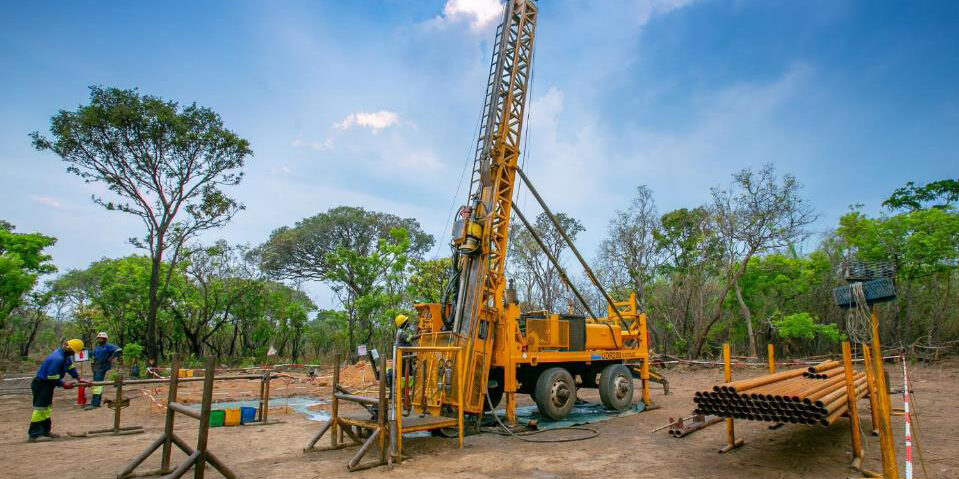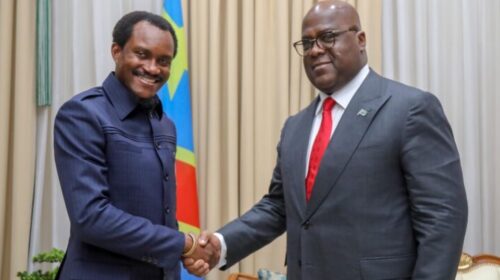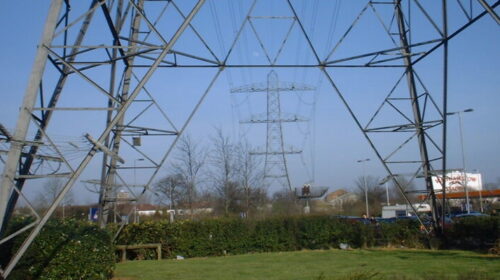Ivanhoe exploration updates in DRC’s Western Foreland licenses
Ivanhoe’s DRC exploration group is targeting Kamoa-Kakula-style copper mineralization on its Western Foreland exploration licences. The 17 licences in the Western Foreland cover a combined area of approximately 2,407 square kilometres to the north, south and west of the Kamoa-Kakula Copper Complex.
The exploration group is using models that successfully led to the discoveries of Kakula, Kakula West, and the Kamoa North Bonanza Zone on the Kamoa-Kakula mining licence. The group is composed of a mixture of the same exploration geologists responsible for these previous discoveries as well as others with experience exploring the greater Central African Copper Belt.
At the Lupemba target area in the far southwest of Western Foreland, ground gravity and a large 800-metre-spaced air core grid continued in the fourth quarter. 69 holes were completed in the fourth quarter, for a total of 150 air-core holes completed in 2022. The air core drilling programs collect samples below the exotic Kalahari sands for geochemistry and lithology identification. Kalahari sands have been moved from great distances and overlay the rocks of interest by as much as 40 metres, thereby acting as a barrier to traditional surface exploration methods such as soil sampling.
Air core samples are analyzed in the same way as soil samples are collected from residual environments, indicating geochemical anomalies for follow-up.
In the Makoko area, exploration focused on testing the six-kilometre western extension of the growth fault corridor that was previously identified by wide-spaced drill sections in 2021.
The 2022 drill program consisted of step-out and in-fill drilling, totalling 8,000 metres across 41 holes. Continuity of mineralization was proven with a current strike length identified to be approximately 11 kilometres. These results will be incorporated into the Mineral Resource estimate for Makoko, planned for mid-year.
Ground gravity geophysical surveys have started on regional, basin-wide traverses, aimed at strengthening the existing airborne gravity data used to identify basin architecture. Previous seismic survey data has recently been re-processed and preliminary results were reviewed in the fourth quarter.
Diamond drilling in the fourth quarter continued with three contractor diamond drill rigs and an Ivanhoe Land Cruiser-mounted diamond drill rig. East of Makoko, a deep drill hole was started on the Kakula-Monwezi trend and will continue drilling in 2023. The hole, located between the Kakula and Makoko deposits, is targeting the host stratigraphy at depth for the continuity of the mineralization system.
At Kakula East, another deep hole was drilled orientated back towards the Kakula deposit from southeast of the Western Forelands decollement. The hole was drilled to understand the geology across the decollement and for targeting any easterly extension of the Kakula deposit’s mineralization across the major tectonic divide. In the Mushiji area, three kilometres north of the Kamoa-Kakula licence, a deep hole was drilled to define the northern extent of the Roan stratigraphy, the hole confirmed the northern limit of the Roan basin but failed to intersect any significant mineralization.
After quarter end, the company announced in February that an independent Mineral Resource estimate for Western Foreland’s Makoko and Kiala high-grade copper discoveries is targeted for mid-2023, followed by a Preliminary Economic Assessment. Concurrently, Western Foreland’s 2023 exploration program is budgeted at approximately $19 million, including up to 70,000 metres of drilling.
Figure 3. Map highlighting Ivanhoe Mines’ current exploration target areas across the Western Foreland licences.
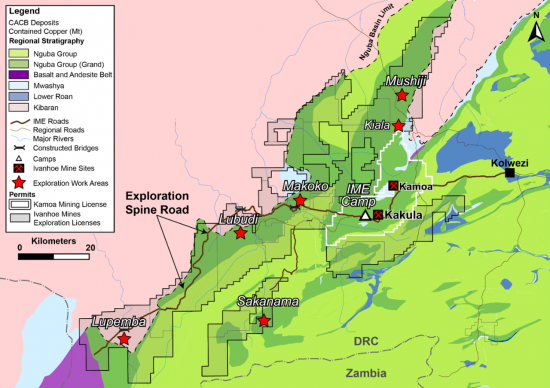
5. The Mokopane Feeder Exploration Project
100%-owned by Ivanhoe Mines
South Africa
Three new 100%-owned exploration rights were granted on the Northern Limb of the Bushveld complex in South Africa during Q4 2022. The three new exploration rights (Blinkwater 244KR, Moordrift 289KR and Lisbon 288KR) cover 80 square kilometres, forming a continuous block situated on the southwest border of the existing Platreef Project’s mining rights.
The three new exploration rights, together with Ivanhoe’s existing properties, cover a large geophysical gravity anomaly that was previously identified from a widely spaced regional ground gravity survey.
Academic studies based on historical data hypothesize that the anomaly represents a primary feeder zone to the Rustenburg Layered Suite of the Northern Limb of the Bushveld Complex. Significant thickening of the Rustenburg Layered Suite, particularly of the more-dense Lower Zone units, is necessary to explain the large gravity anomaly.
The proximity of the proposed feeder to the regional-scale crustal faults (the Ysterberg-Planknek and the Zebediela faults), as well as the anomalously thick zones of platinum-group metals mineralization at the Platreef Deposit, lead Ivanhoe to believe there is significant potential for mineralization to be associated with this gravity feature.
To better understand the conceptual target, a detailed high-resolution airborne-magnetic and gradiometer-gravity geophysical survey commenced over the project area in Q1 2023, with the view to conducting diamond drilling later in the year.
Figure 4. Image of the Platreef and Mokopane Feeder licences overlaid on the gravity geophysics anomaly.
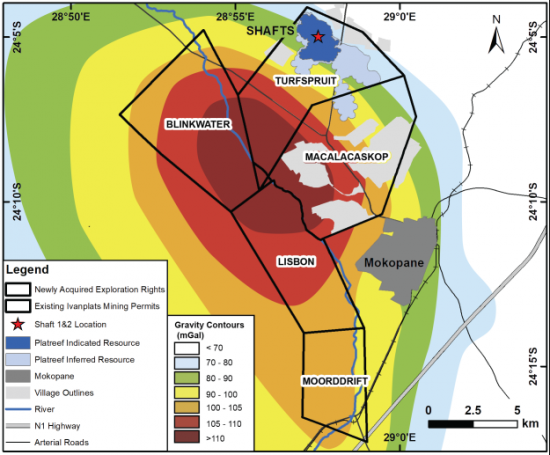
Safety and sustainability
At the end of December 2022, Kamoa-Kakula had reached 1.53 million work hours free of a lost-time injury with a Total Recordable Injury Frequency Rate (TRIFR) (total injuries recorded per 1,000,000 hours worked) of 1.54 for the year ended December 31, 2022. Zero lost time injuries have been recorded on the construction of the Phase 3 expansion, smelter construction and Inga II Turbine #5 refurbishment.
The Platreef Project reached 408,360 hours worked free of a lost-time injury with a TRIFR of 4.23 for the year ended December 31, 2022, and the Kipushi Project reached 658,142 hours worked free of a lost-time injury with a TRIFR of 1.8 for the year ended December 31, 2022.
Ivanhoe mines has published its Fourth Quarter 2022 Sustainability Update on the Company’s website. This can be viewed here: https://bit.ly/3l95VGI
Ivanhoe Mines will issue its sixth annual Sustainability Report in March 2023, highlighting the company’s commitment to ESG and illustrating how it mines with a greater purpose. The report will detail Ivanhoe Mines’ sustainability programs and initiatives in 2022, including significant accomplishments achieved at its three principal development projects, and outline targets and benchmarks for current and future activities.
SELECTED ANNUAL FINANCIAL INFORMATION
This selected financial information is per IFRS as presented in the annual consolidated financial statements. Ivanhoe had no operating revenue in any financial reporting period. All operating revenue from commercial production at Kamoa-Kakula is recognized within the Kamoa Holding joint venture. Ivanhoe did not declare or pay any dividend or distribution in any financial reporting period.
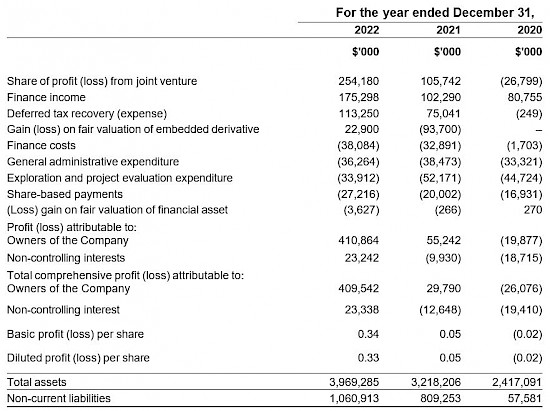
DISCUSSION OF RESULTS OF OPERATIONS
Review of the year ended December 31, 2022, vs. December 31, 2021
The company recorded a profit for the year of $434 million and total comprehensive income of $433 million for the year ended December 31, 2022, compared to a profit of $45 million and total comprehensive income of $17 million for the year ended December 31, 2021. The main contributor to the profit for 2022 was the company’s share of the profit from the Kamoa Holding joint venture.
The company recognized income in aggregate of $405 million from the joint venture in 2022, which can be summarized as follows:

The company’s share of profit from the Kamoa Holding joint venture was $254 million for the year ended December 31, 2022, compared to a profit of $106 million for the same period in 2021, the breakdown of which is summarized in the following table:
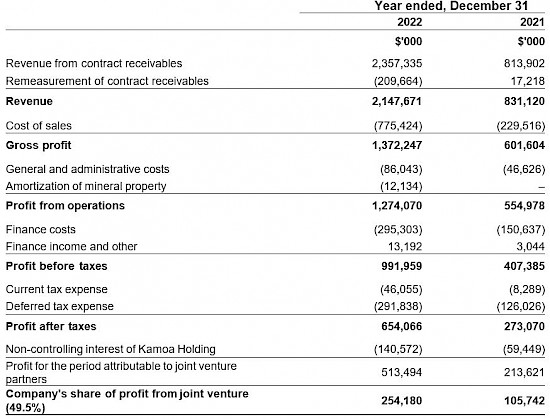
Of the $295 million (2021: $151 million) finance costs recognized in the Kamoa Holding joint venture for 2022, $254 million (2021: $134 million) relates to shareholder loans where each shareholder funded Kamoa Holding in an amount equivalent to its proportionate shareholding interest before generating sufficient operational cashflow.
Of the remaining finance costs, $34 million (2021: $14 million) relates to the provisional payment facility available under Kamoa-Kakula’s offtake agreements, while $7 million (2021: $3 million) relates to the equipment financing facilities.
Exploration and project evaluation expenditure amounted to $34 million for the year ended December 31, 2022, and was $18 million less than for the same period in 2021 ($52 million). Exploration and project evaluation expenditure related to exploration at Ivanhoe’s Western Foreland exploration licences and amounts spent at the Kipushi Project until June 30, 2022, when project development recommenced.
Finance income amounted to $175 million for the year ended December 31, 2022, and $102 million for the same period in 2021. Included in finance income is the interest earned on loans to the Kamoa Holding joint venture to fund operations that amounted to $151 million for 2022, and $94 million for 2021. No additional loans were advanced in 2022 with joint venture cashflow funding its operations and expansions. Interest increased due to higher LIBOR rates and due to the higher accumulated loan balance.
As explained in the accounting for the convertible notes section in the MD&A, the company recognized a gain on fair valuation of the embedded derivative financial liability of $23 million for 2022 (2021: loss of $94 million).
Deferred tax recovery (income) amounted to $113 million for the year ended December 31, 2022, and $75 million for the same period in 2021. The deferred tax recovery in 2022 is related mainly to the Kipushi Project, while the deferred tax recovery in 2021 is related to the Platreef Project.
With the agreement of the development plan by the shareholders of Kipushi and the approval of the development budget consistent with the Kipushi 2022 Feasibility Study in June 2022, it was deemed probable that future taxable profit will be available from the Kipushi Project, against which the unused tax losses and unused tax credits can be utilized. As a result, the company recognized the previously unrecognized deferred tax asset in June 2022, resulting in a deferred tax recovery (income) of $113 million in 2022.
With the completion of the stream financing facilities in December 2021, which will fund a large portion of the Platreef Project’s Phase 1 capital costs, and supported by the excellent results of the Platreef 2022 FS, it was deemed probable that future taxable profit will be available from the Platreef Project, against which the unused tax losses and unused tax credits can be utilized. As a result, the company recognized the previously unrecognized deferred tax asset in December 2021, resulting in a deferred tax recovery (income) of $75 million in 2021.
The total comprehensive income for 2022, included an exchange loss on translation of foreign operations of $1.2 million, compared to an exchange loss on translation of foreign operations recognized for the same period in 2021 of $28 million resulting mainly from the weakening of the South African Rand by 7% from December 31, 2021, to December 31, 2022.
Financial position as at December 31, 2022, vs. December 31, 2021
The company’s total assets increased by $751 million, from $3,218 million as at December 31, 2021, to $3,969 million as at December 31, 2022. The main reason for the increase in total assets was attributable to the increase in the company’s investment in the Kamoa Holding joint venture by $405 million, the increase in property, plant and equipment of $162 million as project development continued at the Platreef and Kipushi projects, as well as the increase in deferred tax assets by $135 million.
The company’s investment in the Kamoa Holding joint venture increased by $405 million from $1,642 million as at December 31, 2021, to $2,047 million as at December 31, 2022. The company’s share of profit from the Kamoa Holding joint venture for 2022, amounted to $254 million, while the interest on the loan to the joint venture amounted to $151 million. The company’s investment in the Kamoa Holding joint venture can be broken down as follows:

The company’s share of net assets in the Kamoa Holding joint venture can be broken down as follows:
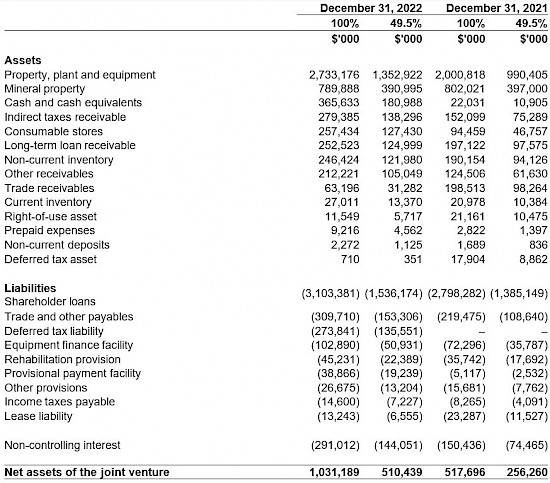
Before commencing commercial production in July 2021, the Kamoa Holding joint venture principally used loans advanced to it by its shareholders to advance the Kamoa-Kakula Copper Complex through investing in development costs and other property, plant and equipment. No additional shareholder loans were advanced in 2022 with joint venture cashflow funding its operations and expansions. The joint venture had a healthy cash position at the end of December 2022 with cash and cash equivalents of $366 million in hand.
The Kamoa-Kakula’s Phase 1 and 2 operations are anticipated to generate significant operating cash flow to fund Phase 3 capital cost requirements at current copper prices and the joint venture is arranging short-term financing facilities should a shortfall occur due to a significant decrease in copper prices.
The cash flows of the Kamoa Holding joint venture can be summarized as follows:
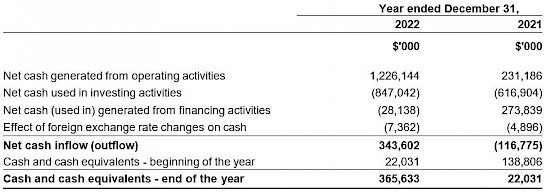
The Kamoa Holding joint venture’s net increase in property, plant and equipment from December 31, 2021, to December 31, 2022, amounted to $732 million and can be further broken down as follows:
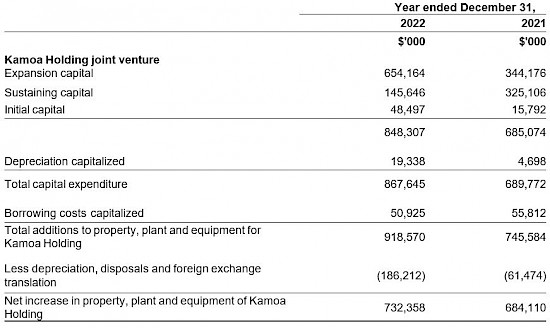
Ivanhoe’s cash and cash equivalents decreased by $11 million, from $608 million as at December 31, 2021, to $597 million as at December 31, 2022. The company spent $159 million on project development and acquiring other property, plant and equipment and generated $177 million from operating activities, which includes the receipt of the second and final prepayment of $225 million under the Ivanplats stream financing agreements.
The net increase in property, plant and equipment amounted to $162 million, with additions of $175 million to project development and other property, plant and equipment. Of this total, $126 million pertained to development costs and other acquisitions of property, plant and equipment at the Platreef Project, while $48 million pertained to development costs and other acquisitions of property, plant and equipment at the Kipushi Project as set out in the MD&A.
The main components of the additions to property, plant and equipment – including capitalized development costs – at the Platreef Project for the year ended December 31, 2022, and for the same period in 2021, are set out in the following table:
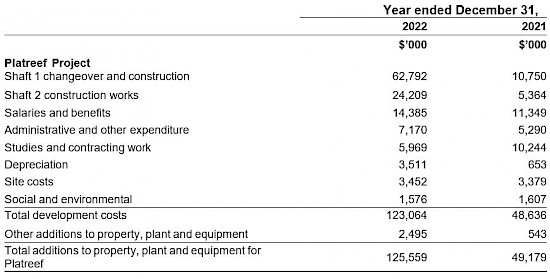
Costs incurred at the Platreef Project are deemed necessary to bring the project to commercial production and are therefore capitalized as property, plant and equipment.
The main components of expenditure at the Kipushi Project for the year ended December 31, 2022, and for the same period in 2021 are set out in the following table:
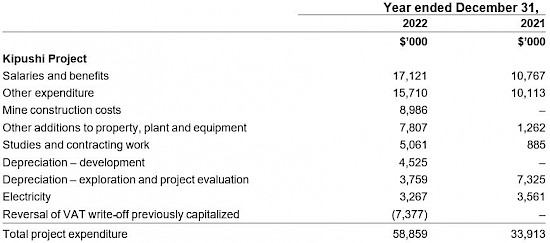
The increase in the Company’s deferred tax asset is related mainly to the recognition of the previously unrecognized deferred tax asset of the Kipushi Project in June 2022, due to the agreement of the development plan by the shareholders of Kipushi, making it probable that future taxable profit will be available from the Kipushi Project, against which the unused tax losses and unused tax credits can be utilized.
The Company’s total liabilities increased by $287 million to $1,128 million as at December 31, 2022, from $841 million as at December 31, 2021, with the increase mainly due to the additional deferred revenue recognized on the streaming facility of $241 million including a notional finance charge and after transaction costs. The deferred revenue represents the prepayment for the future sale of refined gold and palladium and platinum to be delivered by the Platreef Project in the future and will be amortized as ounces are delivered to the Stream Purchasers.
SELECTED QUARTERLY FINANCIAL INFORMATION
The following table summarizes selected financial information for the prior eight quarters. Ivanhoe had no operating revenue in any financial reporting period. All revenue from commercial production at Kamoa-Kakula is recognized within the Kamoa Holding joint venture. Ivanhoe did not declare or pay any dividend or distribution in any financial reporting period.
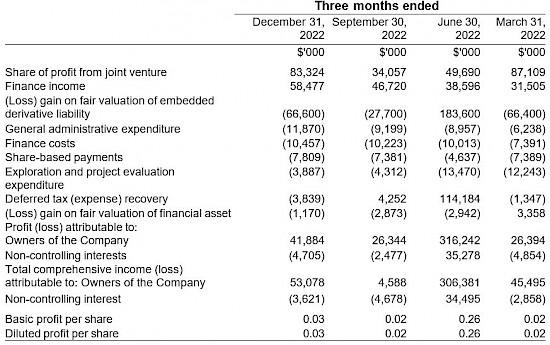
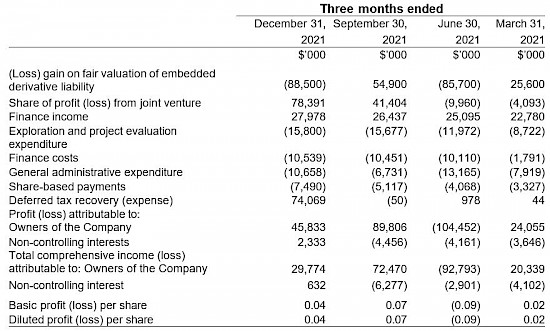
Review of the three months ended December 31, 2022, vs. December 31, 2021
The company recorded a profit for Q4 2022 of $37 million compared to a profit of $48 million for the same period in 2021, with the company’s share of the profit from the Kamoa Holding joint venture being a key contributor to the Q4 2022 profit. The total comprehensive income for Q4 2022 was $49 million compared to $30 million for Q4 2021.
The Kamoa-Kakula Copper Complex sold 92,208 tonnes of payable copper in Q4 2022 realizing revenue of $673 million for the Kamoa Holding joint venture, compared to 53,165 tonnes of payable copper sold for revenue of $489 million for the same period in 2021. The company recognized income in aggregate of $130 million from the joint venture in Q4 2022, which can be summarized as follows:

The company’s share of profit from the Kamoa Holding joint venture was $5 million more in Q4 2022 compared to the same period in 2021 and is broken down in the following table:
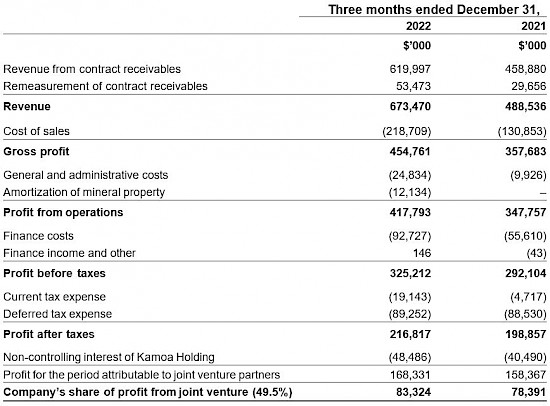
Kamoa-Kakula’s other operating data is summarized under the review of operations section of the MD&A.
Finance income for Q4 2022 amounted to $58 million and was $30 million more than for the same period in 2021 ($28 million). Included in finance income is the interest earned on loans to the Kamoa Holding joint venture to fund past development which amounted to $47 million for Q4 2022, and $26 million for the same period in 2021, and increased due to the higher LIBOR rates and accumulated loan balance.
The company recognized a loss on the fair valuation of the embedded derivative financial liability of $67 million for Q4 2022, compared to a loss on the fair valuation of the embedded derivative financial liability of $89 million for Q4 2021, which is further explained in the accounting for the convertible notes section of the MD&A.
Exploration and project evaluation expenditure amounted to $4 million in Q4 2022 and $16 million for the same period in 2021. Exploration and project evaluation expenditure for Q4 2022 related to exploration at Ivanhoe’s Western Foreland exploration licences, while Q4 2021 also included amounts spent at the Kipushi Project, for which expenditure was capitalized in Q4 2022 due to the recommencement of the development of the project.
LIQUIDITY AND CAPITAL RESOURCES
The company had $597 million in cash and cash equivalents as at December 31, 2022. At this date, the company had consolidated working capital of approximately $611 million, compared to $595 million as at December 31, 2021.
The company’s planned capital expenditure for 2023 and 2024 can be summarized as follows:
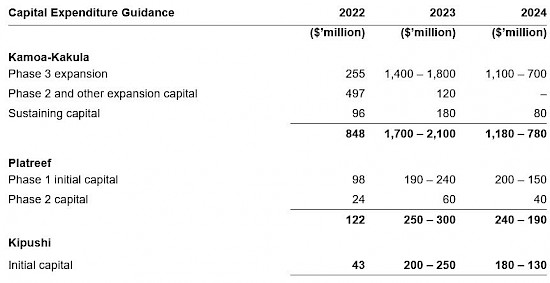
All capital expenditure figures are presented on a 100%-project basis. The 2022 capital expenditure figures above are preliminary and subject to final adjustment. The final capital expenditure figures will be confirmed in the company’s financial results for the fourth quarter and year ended December 31, 2022.
The ranges provided reflect uncertainty in the timing of Kamoa-Kakula Phase 3 expansion, Platreef Phase 2 capital and Kipushi cash flows between calendar years 2023 and 2024. The 2024 capital expenditure guidance for Platreef and Kipushi excludes sustaining capital required in 2024 post-initial production.
As documented in the Kamoa-Kakula 2023 Integrated Development Plan (IDP 2023) announced on January 30, 2023, the remaining capital cost for the total Phase 3 expansion is estimated at $3.0 billion, including the mine, concentrator, smelter, infrastructure and investment in off-site hydropower infrastructure. The Phase 1 and 2 operations are anticipated to generate significant operating cash flow in 2023 and 2024 and are expected to fund capital cost requirements at current copper prices. The joint venture had cash and cash equivalents of $366 million in hand at the end of December 2022.
Construction for Platreef’s Phase 1 Mine is underway, with the first production on track for Q3 2024. The planned Phase 2 capital expenditure at Platreef represents mainly the continuation of sinking Shaft 2 and the construction of the Shaft 2 headframe, allowing optionality for possible acceleration in Phase 2, which is currently under review.
Construction of the Kipushi Mine is also underway, with the processing plant scheduled for completion by Q3 2024. Long-lead equipment items have been ordered and manufacturing is underway, and earthworks and civil construction activities are taking place on the surface. Of the $380 million capital budget to completion, approximately $95 million has been committed to date. Offtake discussions, including a proposed $250 million pre-payment financing facility, have now advanced to final draft term sheets, which have been received from shortlisted parties and are currently under review by Kipushi’s shareholders. The agreements are intended to be completed, as well as a final, revised joint venture agreement between Kipushi Holding and Gécamines, during the first half of 2023.
Exploration activities at the Western Foreland exploration project in the DRC and other targets will continue in 2023 with an initial budget of $31 million.
NON-GAAP FINANCIAL PERFORMANCE MEASURES
Kamoa-Kakula’s C1 cash costs and C1 cash costs per pound
C1 cash costs and C1 cash costs per pound are non-GAAP financial measures. These are disclosed to enable investors to better understand the performance of Kamoa-Kakula in comparison to other copper producers who present results on a similar basis.
C1 cash costs are prepared on a basis consistent with the industry standard definitions by Wood Mackenzie cost guidelines but are not measures recognized under IFRS. In calculating the C1 cash cost, the costs are measured on the same basis as the Company’s share of profit from the Kamoa Holding joint venture that is contained in the financial statements. C1 cash costs are used by management to evaluate operating performance and include all direct mining, processing, and general and administrative costs. Smelter charges and freight deductions on sales to the final port of destination, which are recognized as a component of sales revenues, are added to C1 cash cost to arrive at an approximate cost of finished metal. C1 cash costs and C1 cash costs per pound exclude royalties and production taxes and non-routine charges as they are not direct production costs.
Reconciliation of Kamoa-Kakula’s cost of sales to C1 cash costs, including on a per pound basis:
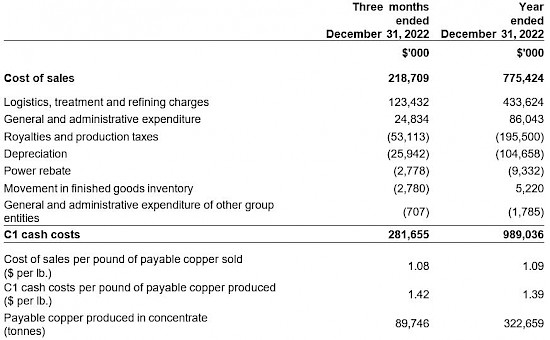
Figures in the above table are for the Kamoa-Kakula joint venture on a 100% basis.
EBITDA, Adjusted EBITDA and EBITDA margin
EBITDA and Adjusted EBITDA are non-GAAP financial measures. Ivanhoe believes that Kamoa-Kakula’s EBITDA is a valuable indicator of the mine’s ability to generate liquidity by producing operating cash flow to fund its working capital needs, service debt obligations, fund capital expenditures and distribute cash to its shareholders. EBITDA and Adjusted EBITDA are also frequently used by investors and analysts for valuation purposes. Kamoa-Kakula’s EBITDA and the EBITDA and Adjusted EBITDA for the Company are intended to provide additional information to investors and analysts and do not have any standardized definition under IFRS and should not be considered in isolation or as a substitute for measures of performance prepared per IFRS. EBITDA and Adjusted EBITDA excludes the impact of cash costs of financing activities and taxes, and the effects of changes in operating working capital balances, and therefore are not necessarily indicative of operating profit or cash flow from operations as determined under IFRS. Other companies may calculate EBITDA and Adjusted EBITDA differently.
The EBITDA margin is an indicator of Kamoa-Kakula’s overall health and denotes its profitability, which is calculated by dividing EBITDA by revenue. The EBITDA margin is intended to provide additional information to investors and analysts, does not have any standardized definition under IFRS, and should not be considered in isolation, or as a substitute, for measures of performance prepared per IFRS.
Reconciliation of profit after tax to Kamoa-Kakula’s EBITDA:

Figures in the above table are for the Kamoa-Kakula joint venture on a 100% basis.
Reconciliation of profit after tax to Ivanhoe’s EBITDA and adjusted EBITDA:
This news release should be read in conjunction with Ivanhoe Mines’ audited 2022 Financial Statements and Management’s Discussion and Analysis report available at www.ivanhoemines.com
71 total views , 1 views today


